Back to the zoo
Welcome back to Building Behaviors at the Niabi Zoo! (To read Part One, click here.)
Teaching cooperative husbandry behaviors is critical to excellent animal care. The many benefits of trainer patience, a shaping plan, excellent observation skills, clicker mechanics, and the ability to modify training sessions based on the animals’ needs can be seen in the video just below of a cotton-top tamarin. In the video, the 14.4-ounce female tamarin calmly follows the target onto the scale for voluntary weights. Even as the scale moves slightly, she remains calm and fluent.
So how did the Niabi Zoo trainers progress toward voluntary weights with the various amazing species in their care? Many of the zoo’s training program successes can be credited to laying the groundwork for consistency; this consistency, and basic foundation behaviors, help both the trainers and the animals.
Did someone say TACOS?
The five foundation behaviors for animals that were taught in KPA’s Dog Trainer Program match the behaviors I learned to teach as a marine mammal and exotic animal trainer, and are the ones we teach at Niabi Zoo.
T = Targeting
A = Attention to trainer
C = Cue a behavior
O = Offer behavior
S = Settle (or what zoo and aquarium trainers call “Stationing”)
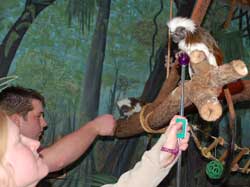
Cotton-top tamarins stationing
with basic hand targets
(Click here to enlarge)
Targeting
Targeting is an essential behavior in our animal training, and at Niabi Zoo it is taught in many variations, including basic, extended, and follow targeting.
Basic targeting teaches an animal to allow a gentle touch from a prop. A prop can be a finger, buoy target (a sturdy plastic ball or marine float on the end of a pole), part of a branch from their habitat, a shape for teaching shape recognition, a spoon that holds a desired food item, or a favorite enrichment toy. The targeting process teaches the animals that a comfortable acceptance of various objects that move near and around them has enjoyable outcomes (click then reinforcement).
When the animals have accepted the gentle touch, we let them process the presence of the target that we used to touch them. Next the animals learn to choose to move toward the target presented only a few inches from them. We click then reinforce for animal exploration and interest in the target. The trainers build solid and reliable basic targeting to fluency amid distractions, in various habitats and locations, and with the primary and secondary trainers.
Extended targeting is when an animal learns to hold a specific location of the body on the target for longer durations of time. With extended targeting, an animal can remain calmly at station while the trainer provides a visual exam of a paw, head, eyes, tail, or coat for husbandry care. Extended targeting trained to fluency (an animal’s or a person’s ability to perform a given behavior with speed and accuracy in any environment) builds on more advanced and complex behaviors.
Follow targeting, or point following, is when an animal follows the target from Point A to Point B. Follow targeting can be seen in the video above, where the tamarin targets for voluntary weights. The female has learned to follow a basic target from her home room, or station, Point A, along the branch to the scale, which is Point B. This variation of targeting is of tremendous value when moving an animal from one habitat to another, onto a scale, into a crate, toward another station location, and/or toward or away from another animal in the habitat. An animal following the movement of a buoy target, a trainer pointing toward location Point B, or a trainer walking toward Point B as the animal follows are all forms of follow targeting.
| This video of cotton-top tamarins shows excellent fluency (TACOS!) amid many distractions. The two birds (conures) make quite the effort to upstage the hard work of the tamarins. |
We teach targeting based on each animal’s natural history and on what is most comfortable for them. The animals at Niabi Zoo are taught to target various body parts, including nose, front hand or paw, back foot or paw, hip, shoulder, and forearm. They target specific body parts to buoy targets onto veterinary scales for voluntary weights, and onto platforms for ventral body exams. The animals learn to target into crates and are also taught visual targeting (the animal looking toward a prop) to a laser pointer.
Fun training and targeting games increase trust between the animals and the training staff. Because of this positive training, the staff has been able to view four newborn black-and-white colobus infants born at the zoo in the past 17 months. The colobus that are at Niabi Zoo are involved in the Species Survival Program (SSP).
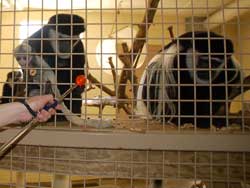
Multiple colobus from a large
troop stationing
(Click here to enlarge)
Attention to the trainers
Amid the flurry of activity that surrounds each training session, the primary goal remains the same: to have each animal relaxed enough to offer attention to the trainers. We want to empower the animals to make the choice to approach the trainer on their own terms and at their own comfort level.
There are times when we have to consider the placement of the animals. What animals should they be near or next to during training? Breeding and hormonal fluctuations, health concerns, changes in the social structure, and infants who are with their mothers and siblings are just some important considerations. We create a safe learning environment so that each animal feels comfortable enough to train and give desired attention to the trainer—even with the presence of a second person in the training area. This second person may be needed to record the weight of the animal on a scale, close a gate, or act as the veterinarian or vet technician. It is through positive successive approximations that the animal becomes acclimated and desensitized to more and more people.
Training becomes second nature to the staff and animals. Capturing simple body movements toward the trainers helps build trust with the animal as well as general attention. Marking a head turn with the click and following the click with a favorite primary reinforcer (mealworms and waxworms for the tamarins) reinforces each small movement to the trainer, which leads to good overall attention over time.
In her new book, Reaching the Animal Mind, Karen Pryor writes, “Clicker training…doesn’t require a personal relationship or personal trust; it builds it.” (Chapter 3 Communication: Cues and Trust, page 53). Once we build attention and trust, trainers and animal can move forward with new training goals.
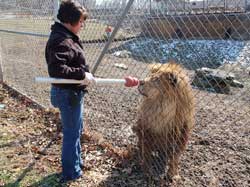
Lion at station with
basic nose targeting
(Click here to enlarge)
Cue a behavior (sometimes the most natural one)
Cues come in many forms at Niabi Zoo. All of the animals are taught to station upon hearing a “start of session” cue. Approaching the station, they see a shape (red circle, blue square, yellow star) that is distinctly theirs. (Think of this shape as their calling card.) Once the animals come to station calmly and/or target on the shape, then the session continues.
Visual, verbal, and tactile cues are taught. We try not to offer compound cues (saying and showing the cue simultaneously). We focus on the fluency of each behavior, shaping precision, latency, and speed. The new cue is introduced upon attention to trainer (therefore reinforcing the attention behavior) when the animal is offering the behavior reliably.
There is a primary trainer for each animal. Once the primary trainer has a behavior reliably under stimulus control, then the behavior is passed on to a secondary trainer. Karen Pryor’s book Don’t Shoot the Dog contains more information about The Rules of Stimulus Control and details her 10 Laws of Shaping.
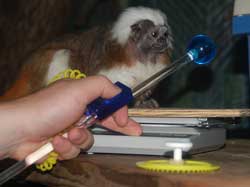
Cotton-top tamarin offering
movement toward scale
(Click here to enlarge)
Offer a behavior (observing what is offered from each animal)
Many behaviors placed on cue at Niabi Zoo were captured. This means that we observed the animals while they offered natural behaviors that we’d like to increase in frequency, clicked then reinforced, and then placed that behavior on cue. For example, every time a cotton-top tamarin moved toward the scale (natural climbing behavior), we would click then reinforce. We were pleased to see this behavior offered after the scale was used as a background prop for weeks.
Stationing
Advanced training cannot occur until foundation behaviors have been trained to fluency. We cannot take voluntary weights with animals if they do not feel safe enough, and if they have not learned to come to a designated location for high-value reinforcement. Stationing is one of the most important foundation behaviors for all animals. It creates the platform upon which to build more complex behaviors that layer on one another over time.
Ken Ramirez shares a great analogy:
We learned as students to report to homeroom upon hearing the bell that signaled classes would commence. We sat at our desks (stationing/shape) and waited for our homeroom teacher to take roll call and cue further directions (open a book to read a chapter, get up to go to gym class, leave homeroom to attend a biology class, and so on). Just like sitting at our desks provided structure and organization to the classroom, stationing provides similar advantages to a training session.
To learn more from Clicker Expo faculty member Ken Ramirez, refer to his book, Animal Training: Successful Animal Management through Positive Reinforcement.
Creating a primary reinforcement hierarchy
Every animal has distinct nutritional requirements and dietary needs. In addition, animals have preferred food items, just as humans do. Niabi Zoo trainers keep track of the food items that have the highest value down to the items that are preferred least for each animal. Do you remember that as young children we did not get our dessert until we ate our fruits and vegetables? Well, Niabi trainers have done an excellent job of training the animals to consume a food item of lower value by reinforcing with a food item of higher value. We incorporate the food hierarchy when increasing distractions, duration, and distance. If an animal holds station on a scale while another animal runs behind unexpectedly, the trainers will click then reinforce the animal on the scale with a higher-value primary reinforce for staying calm during the distraction. Secondary reinforcers are trained and then offered. For the most part, though, food is the main reinforcement for formal training.
TAG me—please!
We are very excited to share that we began TAGteach at Niabi Zoo in August, 2009.
I’m honored to have earned my TAGteach Level 1 Instructor certification through the collaboration with Niabi Zoo and TAGteach International. One of my biggest challenges while TAGteaching is to stop watching the animals—I’m supposed to observe the trainer and give feedback with the Clicker+. Using the Clicker+ is a new mechanical skill that continues to be a wonderful challenge for me.
Click here for a short videotape of a TAGteach session with Niabi trainers and a male gibbon. The TAGpoint is: reinforcement hand at home base. Click here to read my blog about TAGteach at the Niabi Zoo. (The TAGteach video with the gibbon is included in the blog, as is another TAGteach video with trainers and lions.)
We are looking forward to hosting Theresa McKeon at Niabi Zoo in March, 2010. Stay tuned—we’ll offer updates on Theresa’s workshop with the Niabi Zoo keepers.
Niabi Zoo guests learn, too
Zoos and aquariums strive to provide innovative outreach and educational programs to their zoo patrons. As our training program has blossomed, we have started scheduling sessions where the public can observe us training the lions and giraffes. This “Meet & Greet” forum allows us to explain the many benefits of positive reinforcement training programs, particularly clicker training. Our guests enjoy observing training sessions safely while hearing more about their favorite animals. They observe calm and relaxed animals—and trainers that are having fun!
| Kito is watching Mimi (his mom) train along the enclosure border (the camera is not inside with the giraffe). Mimi is very curious about the video camera and gets as close up as she can! Still-pregnant Twiga wanders in the background near Kito. |
Keep on clicking
Now that the critical foundation behaviors have been trained at the Niabi Zoo, many new and more advanced training goals are being created—and then achieved quickly. We are able to teach advanced behaviors because solid basics have been taught in most animal training sessions.
Clicker training and TAGteach have opened up many opportunities for animal program progress as well as exciting staff development. Niabi Zoo continues to be on the cutting edge of behavioral research, working in collaboration with many talented trainers and scientists, among them Dr. Jeanette Thomas, a professor in the Department of Biological Sciences at Western Illinois University-Quad Cities.
We worked with Dr. Thomas on a project that incorporated clicker training into a study of the hearing threshold of the Arctic fox. To date, very little is known about Arctic fox hearing frequency. Each of the male foxes in the study was trained to respond to a tone. The shaping plan included aspects of the TACOS foundation behaviors and taught each fox to leave its station to touch a target upon hearing a tone within its hearing frequency. Both Arctic foxes recently moved to another zoological facility, but our hope is that this valuable research will continue in their new home.
Moving forward, our goals at Niabi Zoo include making progress with voluntary weight training with the large cats, and the colobus and gibbon troops. We also hope to advance stethoscope training with the cotton-top tamarins, stationing and target training with the young colobus infants as they grow into independence away from their mothers, and giraffe husbandry care while the females raise their young calves.
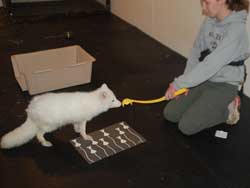
Arctic fox stationing on his
training mat while targeting
(Click here to enlarge)
Finally, some of our future goals are sure to stem from the valuable feedback that will be shared during the upcoming TAGteach seminar at the zoo. We look forward to incorporating Theresa McKeon’s feedback and to learning more about how TAGteach can help with daily animal care and husbandry training.
Sincere thanks to the many individuals who have helped with our training progress at Niabi Zoo and who have offered feedback for these articles, including Niabi Zoo staff and trainers, Dr. Jeanette Thomas, Valerie Bogie, Theresa McKeon, Joan Orr, Ken Ramirez, Karen Pryor, and the faculty of Karen Pryor Academy.
Stay tuned—at Niabi Zoo more training progress is just a click away!
Editor’s note: Laura and the Niabi Zoo continued to make headlines when Quad-Cities Online featured a story on the Niabi Zoo's clicker training program. To read the full article, click here.
Photos and video courtesy of Laura Monaco Torelli, Niabi Zoological Society



Post new comment